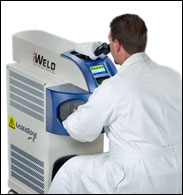Optical Repair Laser Welding
Today’s precision optical repair shops specializing in fast, high quality repairs of eyewear frames and accessories have a wide range of new technologies available to enhance their ability to provide the highest level of quality, craftsmanship and service to their clients. One of the fastest growing technologies is the use of manual laser welding systems as an alternative to traditional solder and fusion welding repair methods.
Laser welders can be used to repair a broken bridge, pad arm, temple, end piece, standard/spring hinge, rim, frame or correct original manufacturer defects. Laser friendly metals include gold, silver, platinum, titanium, steel, stainless steel, base metal, as well as reflow of many variations of solder. Laser welding reconfigures the molecular structure of either similar or dissimilar metals at the point of laser welding, allowing the two common alloys to become one. Eyewear repair shops currently using laser welders are often amazed at the wide range of applications and ability to produce a higher quality product in less time with fewer materials while eliminating excessive heat effects.
How The Laser Welding System Works
One of the key elements in making laser welding applicable to eyewear repair was the development of the “free-moving” concept. In this approach, the laser welder generates a stationary infrared light pulse which is targeted through the microscope’s cross-hair. The laser pulse can be controlled in size and intensity. Because the heat generated remains localized, operators can handle or fixture items with their fingers, laser welding small areas with pin-point accuracy without causing any harm to the operator’s fingers or hands. This free-moving concept enables users to eliminate costly fixturing devices and increase the range of assembly and repair applications.
In laser welding systems, the operator controls the beam diameter (weld spot), power level (voltage) and pulse length depending on the type of alloy and joint being welded. A stereo-microscope with internal cross-hairs make it easy for the operator to align and weld the component part or assembly at the precise location. The laser welding pulse is then activated with a foot pedal. Many laser welding systems also offer the option of a cover gas, normally Argon, to ensure a homogeneous laser weld while preventing any discoloration or contamination.
Most operators can learn to use laser welding machines in a few hours. Although, to become fully proficient and benefit from the machine’s full potential, users must have a good understanding of the metallurgical properties of the alloys being welded. An experienced laser welding technician can typically perform basic manipulation of the repair item within minutes. However, laser welding training is always a good idea to learn more advanced skill sets.
Laser spot welders pose little hazard to operator’s fingers or hands while in the welding chamber. Occasionally, an operator’s fingers may experience a deflected laser pulse, but little damage is done. It is similar to a pin-prick or touching something hot. To ensure the safety of your laser welding system, always ask the manufacturer before you purchase if the machine is FDA certified according to the safety standards established by the Laser Institute of America.
Since most manual laser welders range in pulse energy from 40-150 joules of energy, or 30-50 Watts, they are normally categorized as a Class 4 laser device, the highest-powered Nd:YAG laser available. When the laser welding chamber is fully enclosed, the laser welding system meets the Class 1 safety standards, which is the safest laser to operate.
"I consider myself an eyeglass mechanic and my iWeld is my favorite tool. Once Giles taught me what to look for and how to tweak the iWeld, I quickly started making eyeglass repairs that were impossible or ugly with the torch. The iWeld makes strong, small and invisible repairs possible in every material I have come across. The IiWeld let's me stand out and be different from my competition!" - Brian Bartholow of Leff Optical
Into the Future
 During the last few years, the price of many laser welding systems has decreased, making them increasingly affordable to all levels of optical repair shops, eyewear manufacturers and prototyping laboratories while offering additional features and flexibility for the user. Frequently, those who have purchased a laser system find that the time, labor and material savings realized far outweigh the original purchase price.
During the last few years, the price of many laser welding systems has decreased, making them increasingly affordable to all levels of optical repair shops, eyewear manufacturers and prototyping laboratories while offering additional features and flexibility for the user. Frequently, those who have purchased a laser system find that the time, labor and material savings realized far outweigh the original purchase price.
LaserStar Technologies is the leading supplier of manual laser welding systems for the optical eyewear repair industry. All equipment is manufactured in the USA. LaserStar offers national training facilities in Rhode Island, Florida and California.


